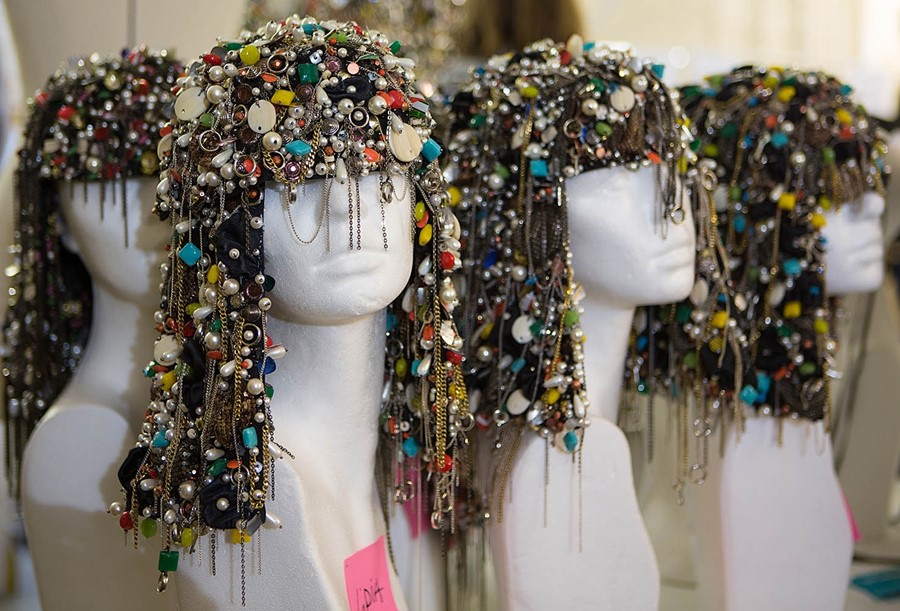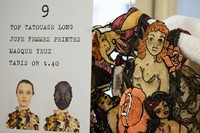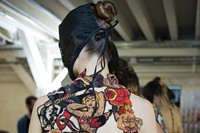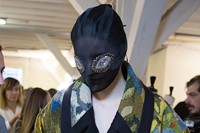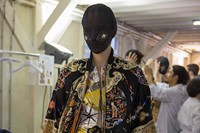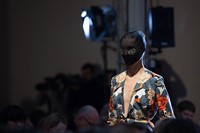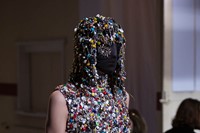Celebrating the quality of Maison Martin Margiela Artisanal show notes
Show notes are a fascinating aspect of the industry. Let's take a moment to consider how different brands approach them.
Some don't bother at all – they prefer the collections to speak for themselves and don't want their audience bothered by numerous bits of paper. Others present a list of credits and special thanks (mum, interns, mates, sponsors etc) on an A4 sheet. The most dated and somewhat frustrating are those who supply three or so paragraphs of abstract adjectives which shed little light on the collection one is seeing. That said, it's always interesting to see an esteemed journalist write the notes, such as Jo-Ann Furniss who excellently explains fabric choices, techniques and key references for Louis Vuitton.
The books/catalogues are always good. Phoebe Philo's Céline inspiration books are brilliant – if you've got the whole collection since her debut you deserve to feel pretty smug – and A/W13's Future Feminism manifesto by Antony Hegarty at Givenchy was a highlight.
However, there is one clear winner when it comes to excellent "show notes". Maison Martin Margiela deserve special recognition for their efforts during couture. The format, use of language and information conveyed is standout. The Maison present descriptions for each look. There's no bumph – just straight-up, interesting info (including production hours) that you would would normally expect to see in an exhibition. It's a pedant's dream.
Here, we present Maison Martin Margiela's shownotes (originally presented in the trademark Courier New font; in both French and English) alongside exclusive backstage photography captured by Emmanuel Sarnin.
---
Since its founding in 1988, Maison Martin Margiela has collected used – and sometimes new – clothes, accessories and objects from around the world. One of the cornerstones of the Maison’s creative expression is resurrecting these vintage pieces and recasting them in a new way that preserves the mark of time. In addition to restoring and reworking these items, they are also reinterpreted in new fabrics. Each Haute Couture piece is made entirely by hand in the Maison’s artisanal atelier. The eccentricity of materials used and the complex and particular processes necessary at each stage of transformation, naturally limit quantities and ensure the unique character of these pieces. A dive into the world of collectors: lifestyle spaces, archives and limited editions. Their interiors are exteriorised, brought to life. Anachronistic and eclectic, composed of stories and accumulations, the collection brings together, mixes and recasts textiles made by artists. A presentation of ornaments, decontextualised and inhabited anew. A collector’s collection.
PASSAGE #1. ROBE DE JOUR
Application of Mariano Fortuny fabric scraps (c.1910 - c.1950) onto a white T-shirt. Production time: 22 hours / Mariano Fortuny scraps sourced in New York, USA – private collection, cotton twill with stencilled motif, cotton jersey.
PASSAGE #2. ROBE DE JOUR
Application of Mariano Fortuny fabric scraps (c.1930) onto a white T-shirt. Production time: 23 hours / Mariano Fortuny scraps sourced in New York, USA – private collection, cotton twill with stencilled motif, cotton jersey.
PASSAGE #3. ROBE BUSTIER
Draping in two variations of “design 706” fabric by Frank Lloyd Wright edited by Schumacher – Taliesin line 1956, mounted on a couture corset. Production time: 49 hours / Frank Lloyd Wright Textiles, sourced in Chicago, USA - private collection silkscreened cotton, silk pongé, nylon bristles.
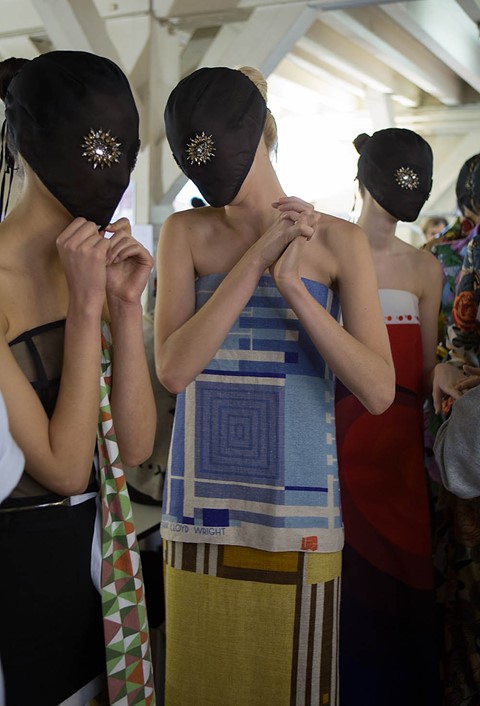
PASSAGE #4. ROBE BUSTIER
Draping in “design 101” and “design 102” fabrics by Frank Lloyd Wright edited by Schumacher – Taliesin line 1955, mounted on a couture corset. Production time: 47 hours / Frank Lloyd Wright textiles sourced in Flagstaff, USA – private collection, Silkscreened linen, silk pongé, nylon bristles.
PASSAGE #5. ROBE BUSTIER
Draping from two hanging textile prints of “Mira Lunar” designed by Verner Panton and edited by Mira-X International in 1979; mounted on a couture corset. Production time: 42 hours / Verner Panton textiles sourced in New York, USA - private collection, printed cotton, silk pongé, nylon bristles.
PASSAGE #6. ENSEMBLE
‘Blouse blanche’ and trousers cut from two variations of “Les violons” fabric prints designed by Raoul Dufy, edited by Bianchini Ferrier. Production time: 38 hours for the blouse and 19 hours for the trousers / Printed cotton from Lyon, France, silk pongé.
PASSAGE #7. TAILLEUR PANTALON
Suit cut in a variation of “Les violons” fabric by Raoul Dufy, edited by Bianchini Ferrier. Production time: 58 hours for the jacket and 19 hours for the trousers / Printed cotton from Lyon, France, silk pongé.
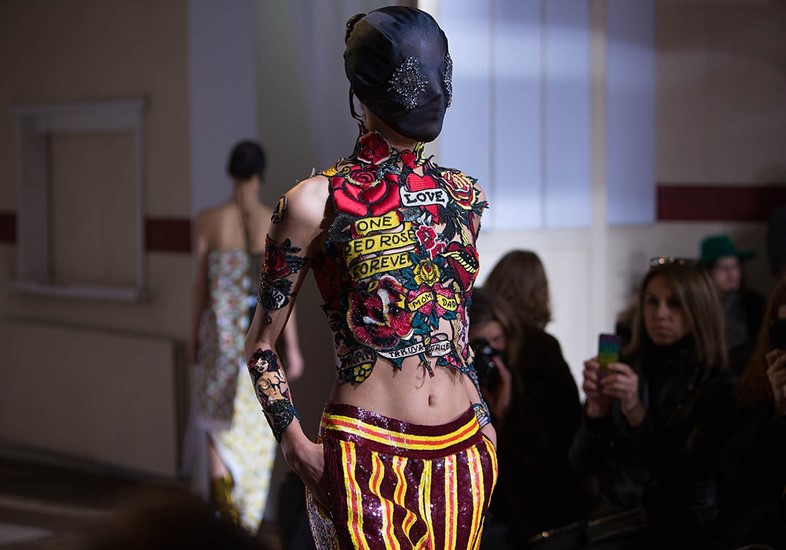
PASSAGE #8. ENSEMBLE
Top made from an assemblage of “tattoo” embroideries based on designs by Sailor Jerry (c.1950), worn with men’s trousers embroidered with sequins. Production time: 51 hours for the top and 19 hours for the pants / Silk organdy, silk pongé, sequin embroidery and mixed needle embroidery: glass beads, half and whole glass tubes, crystals, and silk, cotton and metallic threads.
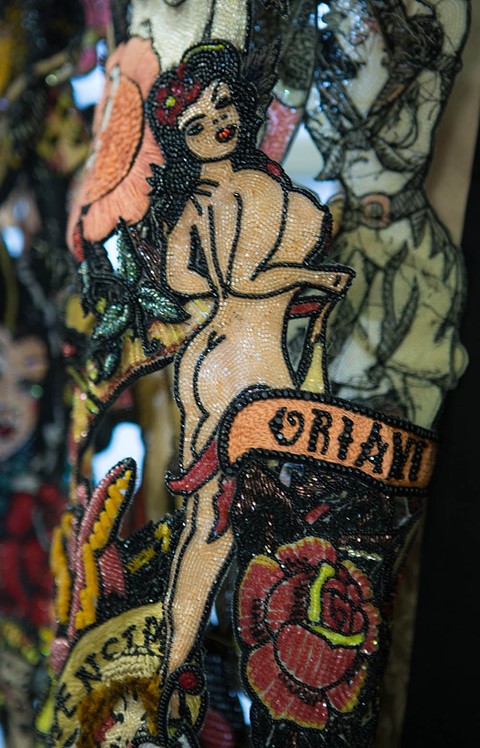
PASSAGE #9. ENSEMBLE
“Buste stockman” blouse made from an assemblage of “Pin-up tattoo” embroidery designed by Sailor Jerry for Rum (c.1950). Pencil skirt made of two handpainted silk scarves once used as décor in a maison close (c.1930 - c.1940). Production time: 57 hours for the blouse and 27 hours for the skirt / Rum labels sourced in Illinois, USA, handpainted silk sourced in Paris, France – private collection, silk satin, mixed needle embroidery: glass beads, half and whole glass tubes and half-tubes, crystals, and silk, cotton, and metallic threads.
PASSAGE #10. VESTE
“Buste stockman” jacket cut from the tapestry “L’Arlequin” by Alain Cornic, edited by Robert Four (c.1960). Production time: 54 hours / Tapestry sourced in Lille, France, silkscreened wool.
PASSAGE #11. MANTEAU
Peacoat cut from a thick tapestry based on “La femme du roi” by Paul Gauguin (1896) produced by the Ateliers Raymond Picaud – Aubusson (c.1950). Production time: 102 hours / Needle woven wool tapestry, sourced at L’Isle-sur-la-Sorgue, France, metal twill.
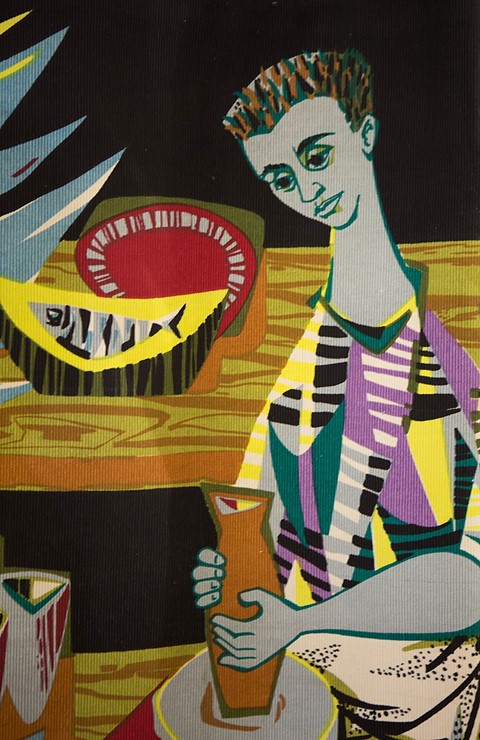
PASSAGE #12. ENSEMBLE
Sleeveless suit embroidered with small found objects, skirt cut from the tapestry “Le Potier” by Robert Debiève, edited by Corot (c.1950). Production time: 65 hours for the jacket and 18 hours for the skirt / Tapestry sourced in Nantes, France – private collection, silkscreened cotton twill, silk organdy, small objects found in flea markets in Paris and Brussels.
PASSAGE #13. ENSEMBLE
“Buste stockman” corset embroidered with small found objects, worn with men’s trousers embroidered with sequins. Production time: 67 hours / Silk organdy, silk pongé, sequins, small objects found in flea markets in Paris and Brussels.
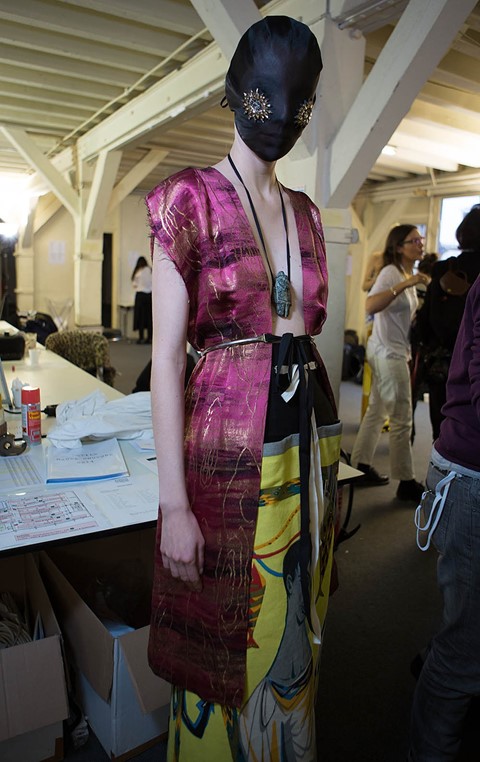
PASSAGE #14. ENSEMBLE
Sleeveless suit jacket cut from a rescue blanket, sleeves embroidered from small found objects. Skirt cut from the tapestry “Le Bosquet” by Jean Lurcat, edited by Corot (c.1950). Production time: 36 hours for the jacket, 20 hours for the sleeves and 18 hours for the skirt / Tapestry sourced in Brussels, Belgium, silkscreened cotton twill, silk organdy, small objects found in flea markets in Paris and Brussels.
PASSAGE # 15. ENSEMBLE
Négligée by the Soeurs Callot (c.1915 - c.1920) and skirt cut from the tapestry “Le Remailleur de filet” by Robert Debieve, produced by Corot (c.1950). Production time: 21 hours for the skirt / Tapestry sourced in Paris, France, négligée by the Soeurs Callot sourced in Brussels, Belgium – rivate collection, silkscreened cotton twill, jacquard in silk and gold thread.
PASSAGE # 16. ENSEMBLE
Evening bomber jacket cut from an Art Deco-era embroidered Chinese jacket (c.1920) worn over a “buste stockman” jacket from an assemblage of aluminium balloons, worn with men’s trousers embroidered with sequins. Production time: 46 hours for the bomber jacket and 15 hours for the jacket / Chinese jacket acquired at a Drouot auction in Paris, France, silk, silk organdy, silk pongé, sequins, silk thread, printed sheets of aluminium.
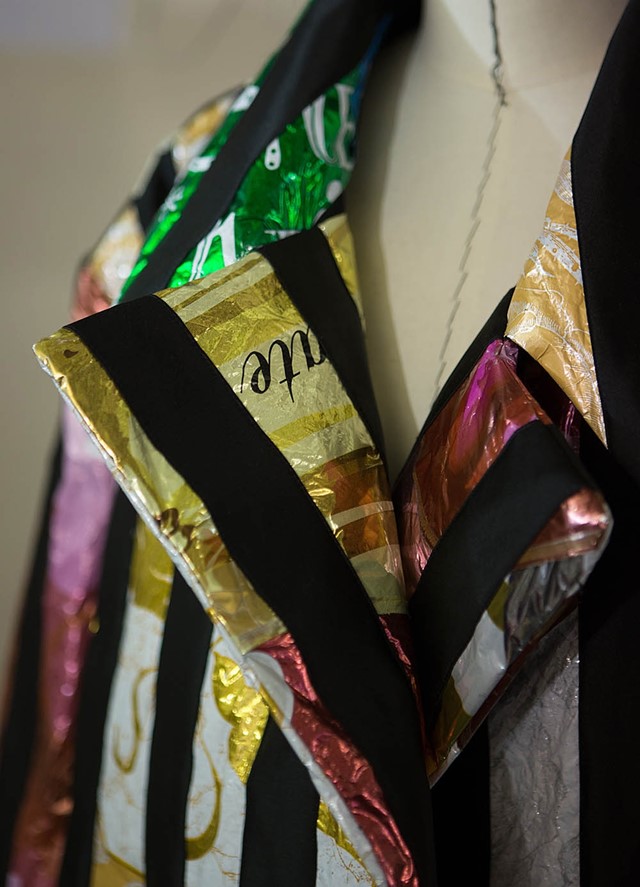
PASSAGE # 17. MANTEAU
Peacoat cut from an assemblage of aluminium balloons held together by satin baguettes, worn with men’s trousers embroidered with sequins. Production time: 105 hours / Duchesse satin, silk organdy, silk pongé, sequins, printed sheets of aluminium.
PASSAGE # 18. ROBE DU SOIR
Draping from a “Label Lap Blanket”, a New York carriage cover-up (c.1900), mounted onto a couture corset. Production time: 48 hours / “Label Lap Blanket” sourced in New York, USA – private collection, silk satin, duchesse satin, cotton poplin.
PASSAGE # 19. PARDESSUS
“Opéra” coat cut from a Bauhaus tapestry produced in Dessau, Germany (c.1920). Production time: 110 hours / Tapestry sourced in New York, USA, wool on cotton twill, metal twill.
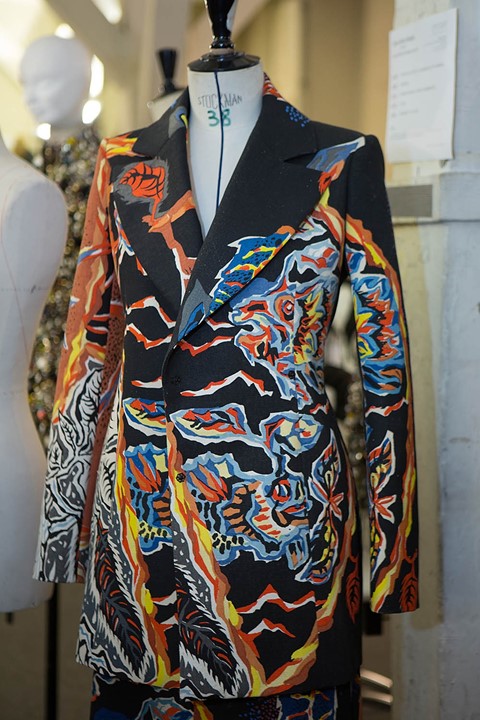
PASSAGE # 20. TAILLEUR JUPE
Skirt suit made from three silkscreens based on the tapestry “La pluie et le beau temps” by Jean Lurçat, edited by Corot (c.1950). Production time: 61 hours for the jacket and 18 hours for the skirt / Tapestries sourced in Lille and Saint-Brieuc, France, silkscreened cotton twill.
PASSAGE # 21. ROBE DU SOIR
Bustier dress cut from the tapestry “Le coq” by Jean Lurçat, edited by Corot (c.1955). Production time: 47 hours / Tapestry sourced in Brussels, Belgium, silkscreened cotton twill, silk satin.
PASSAGE # 22. MANTEAU DU SOIR
Coat cut from the tapestry “D’Étoile” by Jean Lurçat, edited by Corot (c.1950). Production time: 57 hours / Tapestry sourced at the ‘Braderie de Lille’, France, silkscreened cotton twill, silk satin, metal twill.
PASSAGE # 23. ROBE COLONNE
Bustier dress, draped in silk satin. Embroidered “Clin d’oeil” evening gloves. Production time: 27 hours for the dress and 18 hours for the gloves / Silk satin, mixed embroidery: mirror, rhinestones, stones, ceramic, metal discs, glass tube beads.
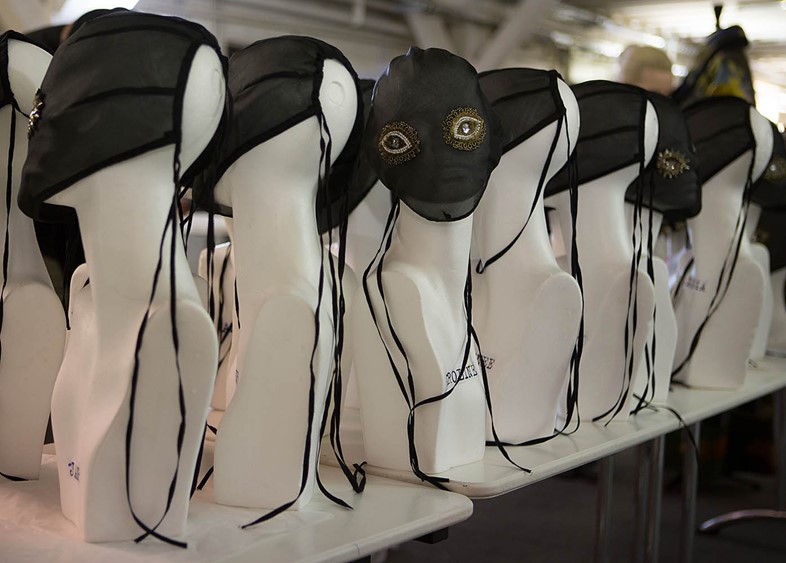
FABRICATION ET RESTAURATION
The veils over the models’ faces are embroidered in our Paris atelier and made of silk organdy, mixed needle embroidery of glass beads, tubes and half-tubes, crystals, and silk, cotton and metal threads. The wigs are made using embroidery and small found objects. The embroideries of small found objects are done by hand and are made of rings, chains, metal beads, cabochons, rounds made from tin cans, glass beads, half and whole glass tubes, crystals, silk, cotton and metallic threads and keys. The ‘Tabi’ ankle boots are made in metal twill. Pre-Columbian art jewellery loaned from a private collection, Antwerp, Belgium.
---
Introduction by Laura Bradley
Notes courtesy of Maison Martin Margiela
